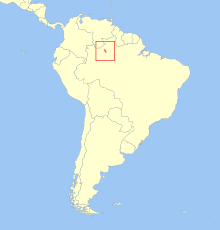Aracá uakari
The Aracá uakari (Cacajao ayresi), also known as the Ayres black uakari,[2] is a newly described species of monkey from the northwest Brazilian Amazon. It was found by Jean-Phillipe Boubli of the University of Auckland after following native Yanomamo Indians on their hunts along the Rio Aracá, a northern tributary of the Rio Negro.[3] It was subsequently described in 2008 together with the more westerly distributed Neblina uakari.[1] Until then, the black-headed uakari was the only species of mainly black uakari that was recognized.[4] Stephen F. Ferrari et al proposed treating the Aracá uakari as a subspecies of the black-headed uakari rather than as a separate species.[5][6]
| Aracá uakari[1] | |
|---|---|
| Scientific classification | |
| Kingdom: | Animalia |
| Phylum: | Chordata |
| Class: | Mammalia |
| Order: | Primates |
| Suborder: | Haplorhini |
| Infraorder: | Simiiformes |
| Family: | Pitheciidae |
| Genus: | Cacajao |
| Species: | C. ayresi |
| Binomial name | |
| Cacajao ayresi Boubli et al., 2008 | |
 | |
| species range | |
This monkey is named after Brazilian biologist José Márcio Ayres, formerly a senior zoologist for the Wildlife Conservation Society. José Márcio Ayres, who died in 2003, pioneered studies in uakaris and played a fundamental role in the creation of the Mamirauá Sustainable Development Reserve,[1] which is of great importance for the white uakari.[7]
Very little is known about the Aracá uakari, but based on present knowledge it has the smallest distribution of all species of uakaris (possibly as small as 5,000–6,000 square kilometres (1,900–2,300 sq mi)) and is the only one not found in any protected area.[2][8] Although few people live within its very remote distribution, it is hunted; at least seasonally.[2] It has been suggested it should be considered endangered,[8] but it is currently listed as least concern by the IUCN.[2]
References
- Boubli, J. P.; M. N. F. da Silva; M. V. Amado; T. Hrbek; F. B. Pontual & I. P. Farias (2008). "A taxonomic reassessment of black uakari monkeys, Cacajao melanocephalus group, Humboldt (1811), with the description of two new species". International Journal of Primatology. 29: 723–749. doi:10.1007/s10764-008-9248-7.
- Boubli, J. (2020). "Cacajao ayresi". IUCN Red List of Threatened Species. 2020: e.T136419A81231569. Retrieved 10 July 2020.
- "New Monkey Species Found in Remote Amazon". National Geographic. 2008-02-04. Archived from the original on 20 April 2010. Retrieved 2010-05-20.
- Groves, C. P. (2005). Wilson, D. E.; Reeder, D. M. (eds.). Mammal Species of the World: A Taxonomic and Geographic Reference (3rd ed.). Baltimore: Johns Hopkins University Press. p. 146. ISBN 0-801-88221-4. OCLC 62265494.
- Ferrari, Stephen F.; Guedes, Patricia G.; Figueriredo-Ready, Wilsea M.B.; Barnett, Adrian A. (2014). "Reconsidering the taxonomy of the Black-Faced Uacaris, Cacajao melanocephalus group (Mammalia: Pitheciidae), from the northern Amazon Basin". Zootaxa. 3866 (3): 353–370. doi:10.11646/zootaxa.3866.3.3. Retrieved 2019-07-24.
- "Cacajao". ASM Mammal Diversity Database. Retrieved 2019-07-24.
- Veiga, L. M., Bowler, M., Silva Jr., J. S., Queiroz, H. L., Boubli, J.-P. & Rylands, A. B. (2008). "Cacajao calvus". IUCN Red List of Threatened Species. 2008. Retrieved 20 May 2010.CS1 maint: uses authors parameter (link) CS1 maint: ref=harv (link)
- "New monkey species is already endangered". New Scientist. 2008-01-19. Archived from the original on 23 January 2008. Retrieved 2008-01-19.
